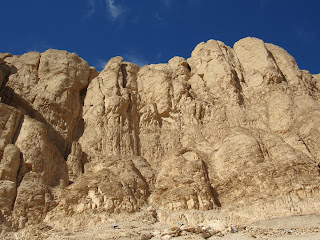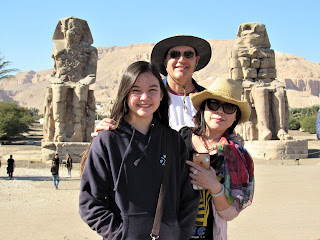Approaching the Temple of Hatshepsut
A travel hipster I'm not. An unapologetic sightseer I am - I could care less about having those so-called "authentic" experiences that the likes of the late Anthony Bourdain would expend so much energy and time on trying (and trying to have us) to attain. Bourdain may have looked scornfully down on someone like myself who made his daughter very happy by taking her on the London Eye, but then again I didn't have the budget that funded his travels, or the entourage (scouting team, camera crew, translator etc.) that made his supposedly "authentic" travels possible. But one thing the late celebrity chef and I have in common is an aversion to guided tours. The idea of being led through a famous sightseeing spot like a herd of cattle by a flag-waving guide, with mandatory stops at restaurants and shops where everyone is getting a cut of the action except the customers isn't my traveling cup of tea (though my wife, being Taiwanese, begs to differ). However, there are times when I'll agree to make an exception. One of those occasions came on our second full day in Luxor, and our plan to visit the west bank, home to the Valley of the Kings et al. Because the sights on the other side of the Nile are much more spread out when compared to those on the east side (where we were staying), I took Lonely Planet's advice and hired a guide and driver for half a day. It turned out to be a wise decision, and there were no buses involved.
It was yet another beautiful day in Egypt. Early-morning balloonists were setting down on the west bank as we sat down for breakfast:
Our guide and driver picked us up at our hotel at 0900 hours and drove across the Nile to the west bank. We learned that the reason for all the tombs being located on that side of the river was because the sun sets in that direction, symbolizing the end of life, which made sense, actually. The scenery en route was mostly rural, with only a few shops:
It took about 45 minutes to reach the famed Valley of the Kings, home to 63 royal tombs connected to pharaohs of the New Kingdom period (1550-1069 BCE). Over the years the tombs have suffered from flooding and looting, which is why the discovery of King Tutankhamun's place of final rest is so celebrated - it was the small tomb of a short-lived pharaoh, but it hadn't been found by robbers, leaving its treasures untouched until Howard Carter arrived on the scene in 1922.
In recent years mass tourism has had a negative effect on the tomb interiors thanks to carbon dioxide and perspiration. As a result, authorities have introduced a rotation system, limiting the number of tombs open to the public at any one time. We explored three tombs while were there - those of Ramses' II, III and IX. Our guide, Shaimaa, didn't accompany us inside - instead, she would explain the significance of each tomb and what to look for, then let us explore the interiors at our leisure while she waited for us outside:
Cameras are not allowed inside the tombs, but visitors are permitted to use their phones. The following pictures were taken by Amber. I can't recall which photos were taken in which tombs, so just enjoy and not worry about which Ramses is associated with which shot:
Coptic Christian graffiti, left by ungrateful Copts who were hiding from persecutors in the tombs:
Our tour did have an obligatory shopping stop, at an alabaster shop called Imhotep, but the hard sell was avoided. We did buy a few pieces to bring home with us:
The girls tried their hands at the manufacturing process:
The highlight of our visit to the west bank was the fantastic Memorial Temple of Hatshepsut, surrounded by limestone cliffs nearly 300 meters (984 feet) above sea level. In Hatshepsut's time (1473-1458 BCE), it was approached by a sphinx-lined avenue and featured a garden. The temple has suffered over time - Hatshepsut's stepson, Tuthmosis III, tried to remove all indications of his stepmother from the structure; Akhenaten removed all references to the deity Amun; and early Christians defaced what they considered to be pagan reliefs. Excavation and restoration has been ongoing since 1891:
Our final stop was at the hella photogenic Colossi of Memnon. Originally representing Pharaoh Amenhotep III, the now-faceless statues stand about 18 meters (59 feet) high. Each one was cut from a single block of stone weighing 1000 tonnes, and sat at the eastern entrance of Amenophis II's funerary temple, which is currently being excavated by Egyptologists. In Greco-Roman times, the colossi were known for a whistling sound made by the northern statue at sunrise. This was due to a crack in the statue's upper body (the result of earthquake damage), but to the Greeks and Romans it was the cry of Memnon greeting his mother Eos, the goddess of dawn. Repairs in the 3rd century CE put an end to the whistling:
In the background can be seen the old village of Gurna. Sitting on top of more tombs, the Egyptian government moved the residents in the 1990's:
Crossing the Nile on our way back to the east bank:
Posing with our guide and driver back at our hotel. I highly recommend Shaimaa's services - we booked her through Aladin Tours, run from the Nefertiti Hotel:
We had a late lunch at the Achti, watching the ferries making their way upriver to and from Aswan:
We didn't have the time on this trip to take one of those ferries, but Amber and I found time in the late afternoon to hire a felucca, a traditional wooden sailing boat, for an hour-long sail along the Nile:
Amber poses with the captain before taking the helm herself:
It was a peaceful ride, and the sunset was stunning:
Back on dry land, the two of us walked into town, while Shu-E rested up in the hotel room. My daughter stops to pose in front of the Winter Palace Hotel, which we had visited the previous day:
We had dinner at a shawarma restaurant next door to the local McDonald's. Our patio table overlooked the square fronting the Temple of Luxor. On the way back to the hotel, we would pick up some fried chicken for my wife from the local KFC. Shu-E apparently missed the Colonel's eleven secret herbs and spices so much that she would actually bring a couple of pieces with her from Cairo back to Addis Ababa!:
And so our time in Luxor would soon come to an end. Three nights isn't enough to see all that this ancient town has to offer, but I'll never forget the things we did visit. And not once did I feel I was somehow "missing out" because of our "inauthentic" experience.






















































































No comments:
Post a Comment